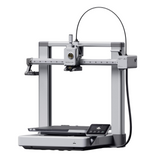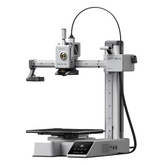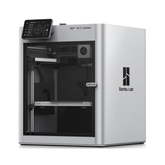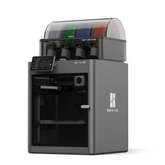AI-Powered 3D Printing: Applications, Benefits, and More
Summary
The convergence of artificial intelligence and additive manufacturing is reshaping how we approach design, production, and innovation.
AI in 3D Printing is one of the most exciting technological partnerships of our time, where intelligent algorithms meet layer-by-layer fabrication to create possibilities that seemed like science fiction just a decade ago.
From aerospace components that optimize themselves for maximum strength-to-weight ratios to medical implants customized for individual patients, this fusion is revolutionizing manufacturing across industries.
Much like how smartphones transformed from simple communication devices into powerful computing platforms, 3D printers are evolving from basic prototyping tools into intelligent manufacturing systems capable of learning, adapting, and improving with every print.

How Artificial Intelligence Enhances 3D Printing Technology
Artificial intelligence technology transforms traditional 3D printing from a largely manual process into an intelligent, self-improving system. AI enhances every stage of the printing workflow, from initial design conception to final quality control.
Traditional 3D printing required extensive human expertise to optimize print settings, troubleshoot failures, and ensure quality outcomes.
Now, intelligent algorithms can analyze thousands of variables simultaneously to make real-time adjustments:
- Layer adhesion quality and consistency
- Temperature fluctuations across the print bed
- Material flow rates and extrusion pressure
- Environmental conditions affecting print stability
- Support structure placement and optimization
Machine learning algorithms examine historical print data to identify patterns that lead to successful prints versus those that result in failures. This knowledge becomes institutional memory that improves with every completed project.
AI and 3D printing work together to predict potential issues before they occur, automatically adjusting parameters like print speed, temperature, and support structure placement to prevent warping, layer separation, or dimensional inaccuracies.
The integration goes deeper than simple parameter optimization. AI models can now generate entirely new designs based on functional requirements, creating structures that no human designer might conceive.
These generative design algorithms explore thousands of possible configurations, testing them virtually before recommending optimal solutions that balance performance, material usage, and manufacturing constraints.
Key Applications of AI in 3D Printing
The application of artificial intelligence in 3D printing spans numerous industries, each leveraging this technology to solve unique challenges.
Healthcare Applications
In healthcare, AI-powered systems analyze medical imaging data to create patient-specific solutions:
- Custom implants matching exact patient anatomy
- Personalized prosthetics with optimized fit and function
- Patient-specific surgical guides for complex procedures
- Biocompatible scaffolds for tissue engineering
- Dental aligners and orthodontic devices
Aerospace and Defense
Aerospace manufacturers utilize 3D printing with AI technology to create lightweight components with internal structures optimized for specific stress patterns.
These designs often resemble organic forms—honeycomb patterns, tree-like supports, or cellular structures—that provide maximum strength with minimal material usage.
Key aerospace applications include:
- Turbine blades with internal cooling channels
- Lightweight satellite components
- Custom tooling for aircraft assembly
- Rapid prototyping of aerodynamic surfaces
- Mission-specific equipment for space exploration
Automotive Industry
Automotive companies employ AI based 3D printing for both prototyping and production applications:
- Rapid prototyping of new vehicle components
- Custom tooling, jigs, and manufacturing fixtures
- Low-volume production of specialized parts
- Crash test components with optimized safety features
- Lightweight structures for electric vehicle efficiency
In architecture and construction, 3D printing using AI enables the creation of complex geometries that would be impossible or prohibitively expensive using traditional construction methods.
AI algorithms can optimize building designs for local climate conditions, structural requirements, and material availability while ensuring the structures can be successfully printed using large-scale 3D printing systems.
Benefits of AI-Driven 3D Printing for Industries
The advancements in additive manufacturing driven by artificial intelligence deliver tangible benefits that extend far beyond improved print quality. Some these benefits include the following:
Cost Reduction Benefits
Cost reduction are one of the most immediate advantages:
- Minimized material waste through optimized designs
- Reduced failed prints through predictive quality control
- Lower labor costs due to automated processes
- Elimination of expensive tooling for custom parts
- Reduced inventory requirements for spare parts
Speed and Efficiency Improvements
How AI can Help 3D Printing becomes evident in reduced time-to-market for new products:
- Simultaneous optimization of multiple design criteria
- Elimination of iterative trial-and-error approaches
- Automated parameter selection and adjustment
- Faster design iteration cycles
- Reduced setup time between different print jobs
Quality consistency improves dramatically when artificial intelligence impacts on 3D printing processes. Human operators, regardless of their expertise, introduce variability in decision-making and parameter selection.
AI systems maintain consistent performance standards, applying learned best practices to every print job.
Enhanced Customization Capabilities
Customization capabilities expand exponentially with AI integration:
- Mass customization at scale without tooling changes
- Patient-specific medical devices and implants
- Personalized consumer products
- Application-specific industrial components
- Adaptive designs that respond to usage patterns
Role of Machine Learning in Optimizing Print Quality
Machine learning algorithms are the intelligence behind quality optimization in modern 3D printing process management.
These systems continuously analyze sensor data from active prints, building comprehensive understanding of how various factors influence final part quality.
Real-Time Monitoring Systems
Advanced monitoring incorporates multiple data sources:
- Temperature sensors across the print bed and extruder
- Vibration detectors for mechanical stability
- Optical monitoring systems for visual quality assessment
- Material flow sensors for consistent extrusion
- Environmental sensors for ambient condition tracking
AI based 3D slicing software exemplifies machine learning's practical application in print optimization. Traditional slicing software applies fixed rules to convert 3D models into printer instructions.
Machine learning-enhanced slicers analyze the specific geometry being printed, the material properties, and historical performance data to generate optimized tool paths.
Computer Vision Applications
Real-time quality monitoring is another crucial machine learning application:
- Identification of layer adhesion problems as they develop
- Detection of dimensional drift during printing
- Recognition of material flow irregularities
- Automated defect classification and reporting
- Predictive failure analysis based on visual patterns
Large language models are beginning to play roles in 3D printing optimization as well, particularly in translating design requirements into manufacturing instructions.
These AI systems can interpret natural language descriptions of desired part characteristics and suggest appropriate materials, printing parameters, and post-processing steps.
Top 3 AI Based 3D Printer
Bambu Lab A1
The Bambu Lab A1 is a breakthrough in consumer-accessible AI 3D printing technology. This printer incorporates advanced computer vision systems that continuously monitor print progress, automatically detecting and correcting common printing issues.
Key AI features of the A1 include:
- Automatic bed leveling with precision sensors
- Real-time filament detection and monitoring
- Intelligent failure recovery systems
- Computer vision-based quality monitoring
- Automatic calibration for consistent results
The AI-powered automatic calibration system eliminates the tedious manual adjustments traditionally required for consistent results.
When the AI detects potential problems like layer shifting or material flow issues, it can pause the print, make necessary adjustments, and resume printing without human intervention.
Bambu Lab A1 Mini
The Bambu Lab A1 Mini brings AI-enhanced printing capabilities to an even more compact and affordable form factor.
Despite its smaller size, this printer maintains many of the intelligent features found in larger systems.
Smart features of the A1 Mini include:
- AI-driven print monitoring with failure detection
- Automatic parameter optimization for different materials
- Real-time environmental condition compensation
- Intelligent print speed and temperature adjustment
- Compact sensor array for quality monitoring
The AI-driven print monitoring system uses machine learning algorithms trained on thousands of successful and failed prints to recognize quality issues before they compromise the final result.
The system can adjust printing speeds, temperatures, and cooling settings in real-time to maintain optimal print quality regardless of external factors.
Bambu Lab X1E
The Bambu Lab X1E is the pinnacle of AI integration in desktop 3D printing. This premium system incorporates advanced sensor arrays and processing power that enable sophisticated real-time analysis and optimization.
Advanced capabilities of the X1E include:
- Comprehensive sensor arrays for multi-parameter monitoring
- Advanced material compatibility with automatic optimization
- Predictive maintenance scheduling
- Performance optimization based on usage patterns
- Design suggestions based on printing history
The X1E's AI capabilities extend beyond basic quality monitoring to include predictive maintenance, performance optimization, and even design suggestions based on printing history and material characteristics.
The printer's learning algorithms continuously refine settings based on actual printing results, building a personalized database of optimal parameters for each user's specific printing environment and requirements.
Conclusion
The integration of artificial intelligence with 3D printing technology marks a fundamental shift in how we approach manufacturing, design, and innovation.
From intelligent quality monitoring systems that prevent failures before they occur to generative design algorithms that create optimized structures beyond human imagination, AI is transforming additive manufacturing from a prototyping tool into a production-ready technology.
The benefits extend across industries, offering cost reductions, quality improvements, and customization capabilities that traditional manufacturing methods cannot match.
As AI systems continue learning and evolving, we can expect even more sophisticated capabilities that will further blur the lines between digital design and physical reality, making the impossible not just possible, but practical and affordable.














